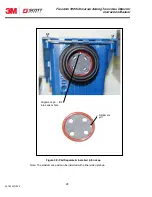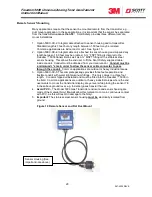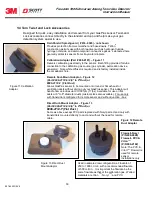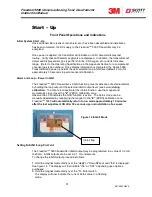
16
087-0020 REV
E
THE SCOTT SAFETY
GAS SENSOR
Overview of Sensor Operation
Scott Safety manufactures two types of electrochemical gas
sensors. These being the traditional GasPlus sensor and
the Rock Solid
GasPlus sensor. Both sensor types
provide reliable gas detection but the Rock Solid
sensor
provides superior zero stability, faster response time, and
higher specificity to the target gas. Both of these specialized
electrochemical gas sensors detect target gases for which
they were designed through a series of electrochemical
reactions. Gas passes through a gas permeable membrane
where it then contacts an electrolyte – saturated membrane
.
The gas is then oxidized or reduced (depending on the gas)
at the sensing electrode, and the reaction is balanced at the
counter electrode. In most traditional sensors, a third
electrode acts as a reference to maintain a fixed potential at
the sensing electrode. As gas concentration increases, a
corresponding increase in current output occurs. The current
output is measured and amplified, then converted by the
Series 5000 transmitter to a signal on the 4–20 mA loops
where it is used to read gas concentration.
The Sensor and Battery
Figure 2 Sensor Operation
Each GasPlus ‘smart’ sensor contains circuitry with an
EEPROM and lithium battery. The EEPROM retains specific
sensor data including gas measuring type, range, alarm set-
points, and sensor calibration factor. When connected to the
transmitter, the sensor data is up loaded to the transmitter.
Upon disconnection of the GasPlus sensor from transmitter
assembly, the bias potential (required by electrochemical
sensors) across the sensor’s electrodes will be maintained
via the integral battery. The battery is capable of providing
up to a total of 9 months of “off - line” power (because the
battery is not rechargeable, “off - line” time is cumulative),
providing proper storage procedures are followed. Store the
sensor in a cool dry place (such as a refrigerator). Do not
store the sensor in excessively hot, dry or humid
environments. Should the sensor be kept off-line for a
cumulative period of time exceeding 9 months, the sensor
will continue to operate! Sensor battery failure does not
mean the sensor has failed and will not operate, only that it
will require a 4-8 hour warm-up time upon installation. On
the sensor has become stable, calibration may occur as
normal.
Freedom 5000 Universal Analog Toxic Gas Detector
Instruction Manual






























